Apple iPhone 4S: Thoroughly Reviewed
by Anand Lal Shimpi & Brian Klug on October 31, 2011 7:45 PM EST- Posted in
- Smartphones
- Apple
- Mobile
- iPhone
- iPhone 4S
Faster Throughput on WCDMA
Fixing unintended attenuation is only one part of what’s new however, the other part of the story is faster cellular connectivity for users on WCDMA/UMTS carriers. Users who are using the 4S on CDMA (like Sprint or Verizon) won’t see a performance difference since this is still the same EVDO Rev.A.
The iPhone 4 used an Intel/Infineon X-Gold 618 which supported HSDPA 7.2 and HSUPA 5.76. The MDM6610 inside the 4S supports HSDPA 14.4 and HSUPA 5.76, alongside a number of 3GPP Rel.7 features which are colloquially known as HSPA+. I talked about this extensively in another piece when there was some confusion about whether or not the 4S is HSPA+ - which it is.
| iPhone Cellular Speeds | ||||
| Property | iPhone 3G/3GS | iPhone 4 (GSM/UMTS) | iPhone 4 (CDMA) | iPhone 4S |
| Baseband | Infineon X-Gold 608 | Infineon X-Gold 618 | Qualcomm MDM6600 | Qualcomm MDM6610 |
| HSDPA | Cat.8 - 7.2 Mbps | Cat.8 - 7.2 Mbps | N/A | Cat.10 - 14.4 Mbps |
| HSUPA | None - 384 Kbps WCDMA only | Cat.6 - 5.76 Mbps | N/A | Cat.6 - 5.76 Mbps |
| EVDO | N/A | N/A | 1x/EVDO Rev.A | 1x/EVDO Rev.A |
The previous X-Gold 618 baseband was a nice improvement over the iPhone 3G/3GS’ X-Gold 608, which lacked HSUPA, but in a world where most WCDMA carriers are at least running HSDPA 14.4, it’s nice to finally have an iPhone with something faster than HSDPA 7.2. I’ve done lots of testing inside my Tucson, AZ market (which is “4G” HSPA+ on AT&T’s coverage viewer) with both the 4 and the 4S, and have built a very good feel for the 4’s performance. As a reminder, if you’re in the USA, those dark blue areas represent HSPA+ coverage areas with AT&T’s upgraded backhaul. In practice these are at least HSDPA 14.4.

Left: iPhone 4 Limited to ~6.1 Mbps down, Right: iPhone 4S (same location) hitting ~9 Mbps
With line of sight to an AT&T NodeB inside my HSPA+ market I’m used to seeing a maximum downstream throughput on the iPhone 4 of almost exactly ~6.1 Mbps, which is about right for the 4’s HSDPA 7.2 maximum when you include overhead. The nice straight line in that result should clue you in that downstream throughput on the 4 was being gated by the baseband. On the 4S, in this same location, I’ve been able to get 9.9 Mbps when the cell isn’t loaded at night (I didn't grab a screenshot of that one, for some reason). It’s nice to finally not be gated by the baseband anymore on an iDevice. Having a faster baseband is part of the reason the 4S’s cellular performance is much better, the other half is receive diversity which helps the 4S push these high throughput rates, and also dramatically improve performance at cell edge.
I did some drive testing with the 4 and 4S side by side and targeted areas that I know have pretty poor signal strength. The 4S is shown in yellow, the 4 in blue.
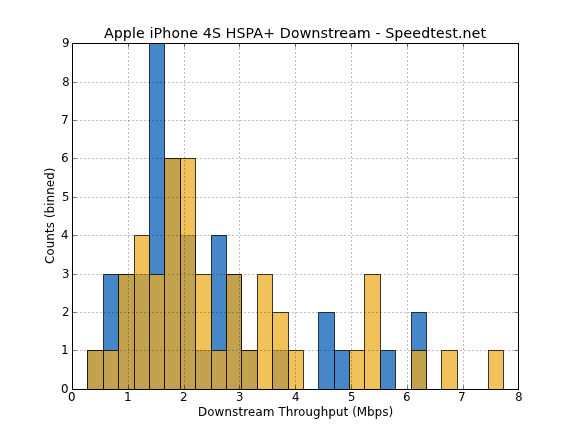
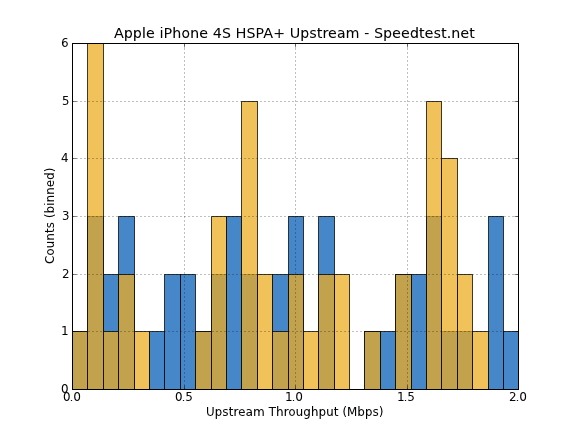
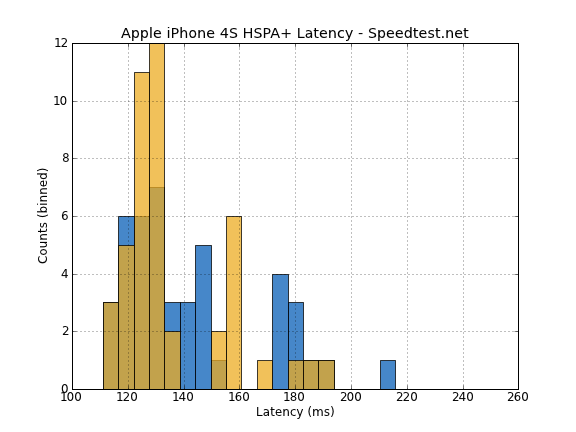
You can see how downstream throughput gets a nice shift up, and the average changes as well, from 2.28 Mbps on the 4 to 2.72 Mbps on the 4S. The maximum in this sample increases from 6.25 to 7.62 Mbps as well. It isn’t a huge shift, but subjectively I’ve noticed the 4S going a lot faster in areas that previously were difficult for the 4.
We’ve also run the usual set of standalone tests on the 4S on AT&T in my market of Tucson, AZ, in Anand’s market of Raleigh, NC, and on Verizon in Raleigh, NC. Though we don’t have a Sprint 4S yet, we hope to do a more serious 4S carrier comparison here in the US when we get one. First up is AT&T which is of course HSPA+ in both of our testing markets.
AT&T HSPA+
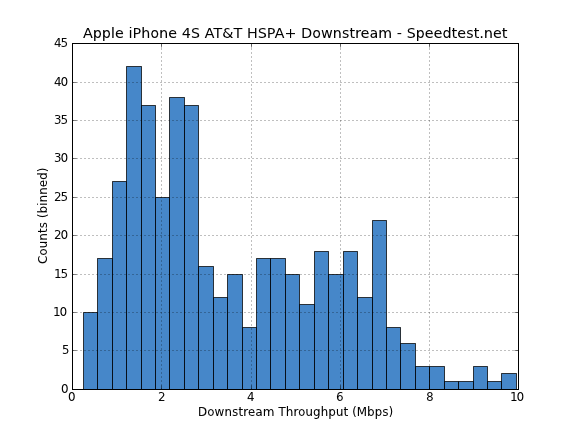
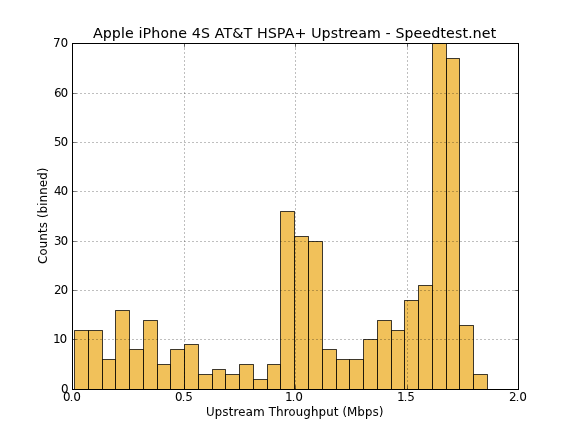

Verizon EVDO
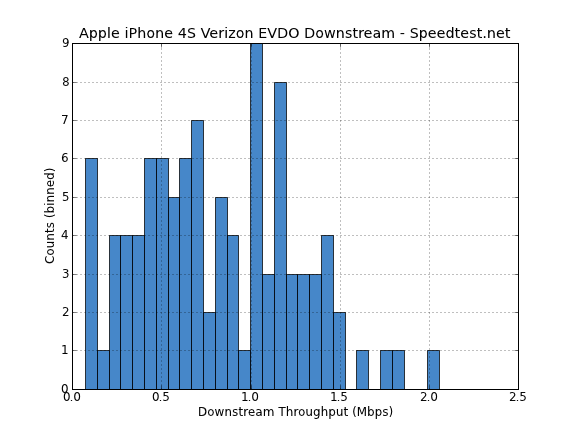
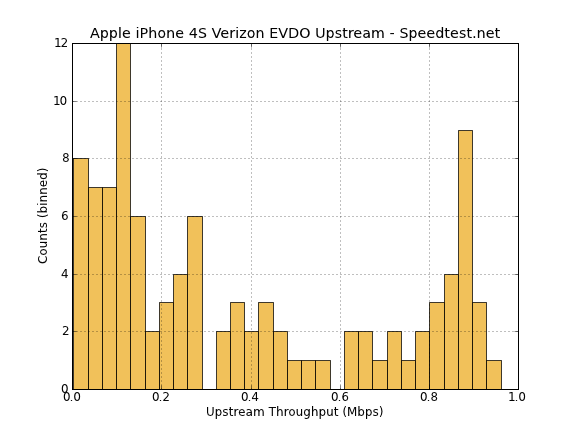

| iPhone 4S Speedtest Comparison | ||||||
| Carrier | AT&T | Verizon | ||||
| Avg | Max | Min | Avg | Max | Min | |
| Downstream (Mbps) | 3.53 | 9.94 | 0.24 | 0.82 | 2.05 | 0.07 |
| Upstream (Mbps) | 1.17 | 1.86 | 0.009 | 0.38 | 0.96 | 0.003 |
| Latency (ms) | 137 | 784 | 95 | 177 | 1383 | 104 |
| Total Tests | 457 | 150 | ||||
| Air Interface |
HSPA+ (HSDPA 14.4/HSUPA 5.76) |
EVDO Rev.A | ||||
For the CDMA carriers, the 4S shouldn’t (and doesn’t) bring any huge improvement to data throughput because the CDMA 4 had both receive diversity and MDM66x0. For users on GSM/UMTS, however, the 4S does make a difference again thanks to the inclusion of those two new features.
One of the things I noticed was absent on the CDMA iPhone 4 was the 3G toggle. It does indeed make some sense to not include this in a CDMA 1x/EVDO scenario since power draw is about the same between the two air interfaces, however, the absence of this toggle has carried over to the 4S regardless of whether the phone is activated on a CDMA2000 or UMTS/GSM network. That’s right, you can go under Settings -> General -> Network, and there’s no longer any 3G Data toggle which you can disable and fall onto EDGE (2G) with now.
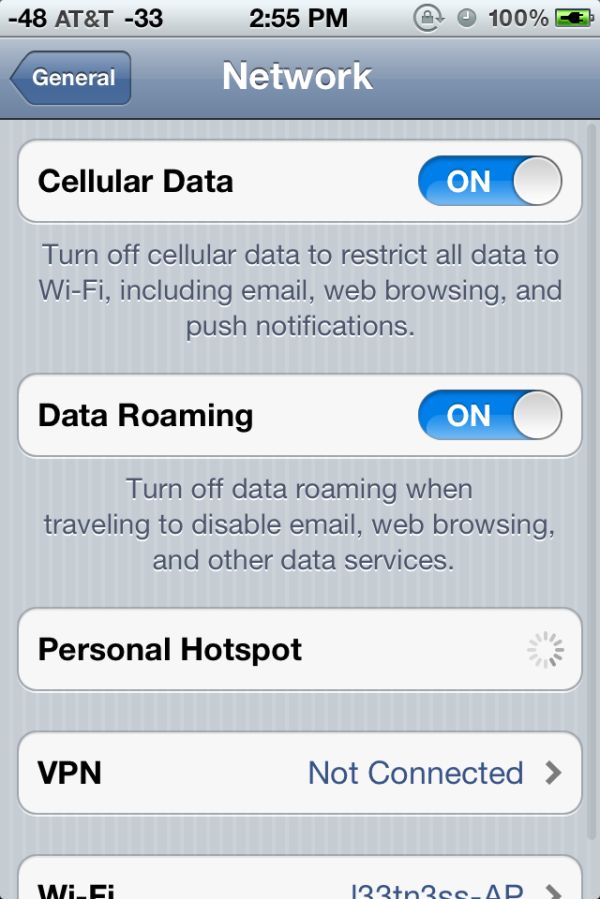
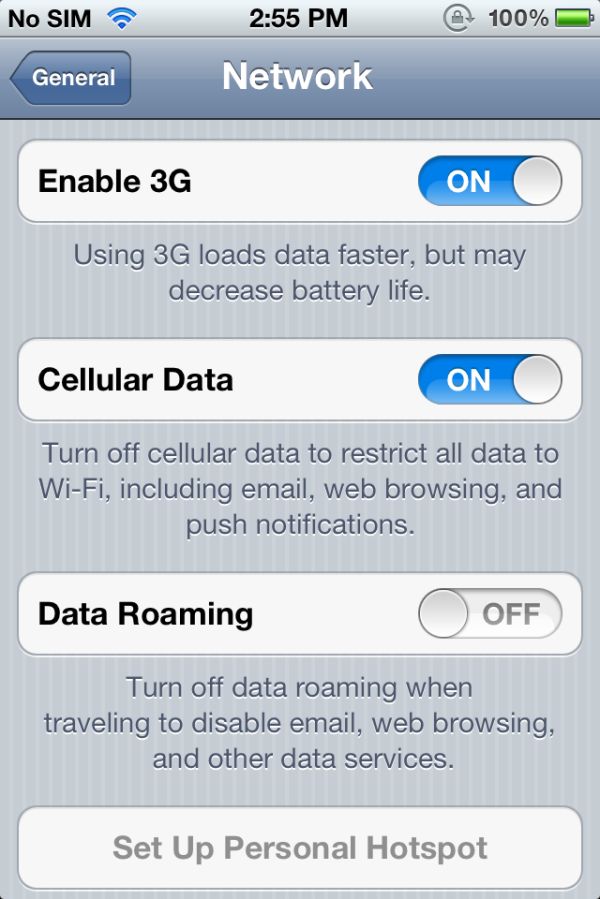
Left: iPhone 4S (no 3G toggle), Right: iPhone 4 (3G toggle)
It’s likely that this is absent to accommodate the multi-mode nature of the 4S (and thus the lowest common denominator CDMA mode), however the absence of this toggle makes getting connected in congested areas more difficult. In some markets, (I’m looking at you, AT&T in Las Vegas), EDGE is often the only way to get any connectivity, even without a major convention going on. Not having that 3G toggle makes manually selecting that less-used but more reliable connection impossible now, to say nothing of the potential battery savings that this would afford (and that we sadly can’t test now).
There’s one last tangential question about HSPA+ on the 4S, specifically on AT&T. I’ve left this to the end since it doesn’t impact non-US 4S users, but the last question is whether the 4S is actually on HSPA+. For a while, I was concerned that AT&T would continue using the wap.cingular APN on the 4S which seems shaped to around 7.2 Mbps HSDPA. I’m glad to report that AT&T hasn’t continued using wap.cingular on its 4S data plans, instead using “phone” which is a newer APN that allows for HSPA+ (above 7.2 Mbps) rates. You can check this yourself under PDP Context Info on the 4S in field test.


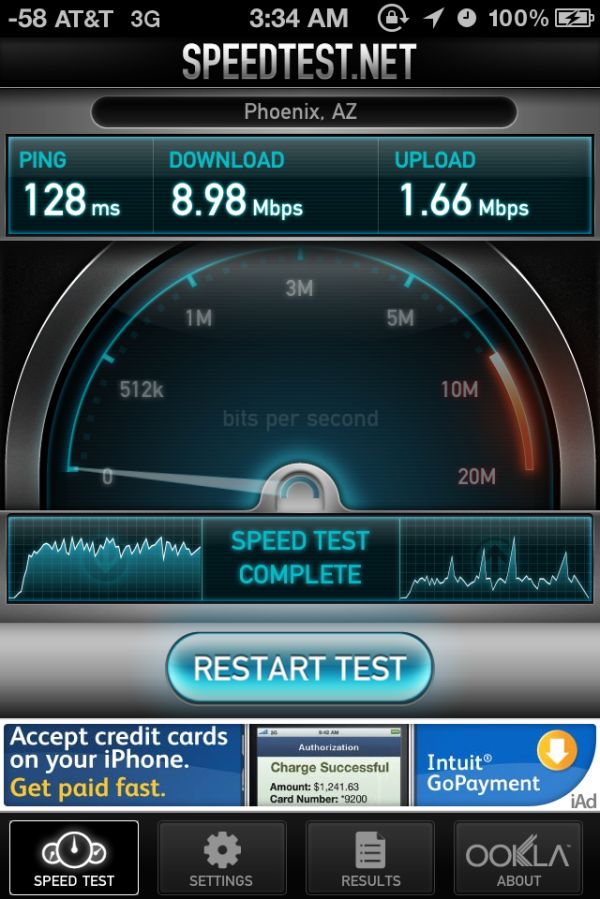
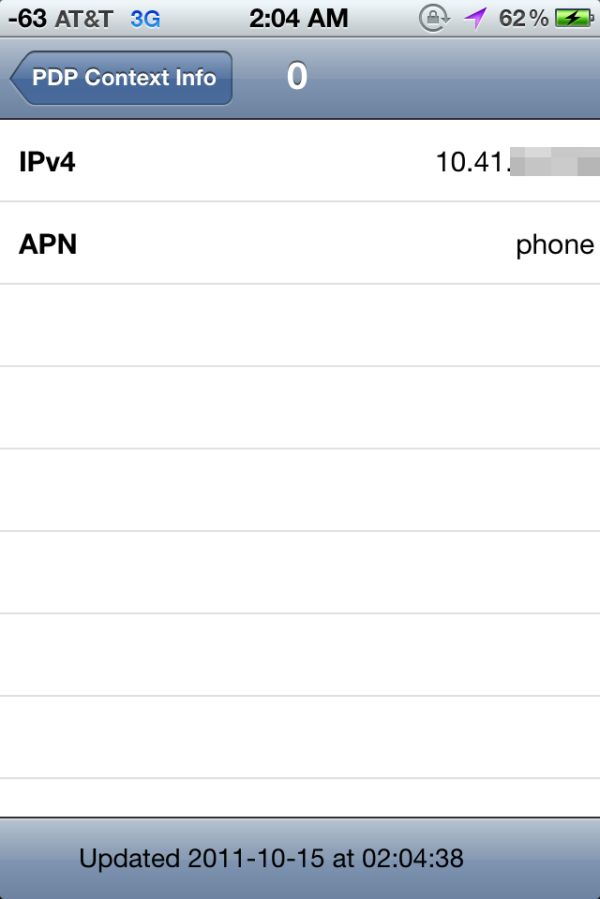








199 Comments
View All Comments
robco - Monday, October 31, 2011 - link
I've been using the 4S from launch day and agree that Siri needs some work. That being said, it's pretty good for beta software. I would imagine Apple released it as a bonus for 4S buyers, but also to keep the load on their servers small while they get some real-world data before the final version comes in an update.The new camera is great. As for me, I'm glad Apple is resisting the urge to make the screen larger. The Galaxy Nexus looks nice, but the screen will be 4.65". I want a smartphone, not a tablet that makes phone calls. I honestly wouldn't want to carry something much larger than the iPhone and I would imagine I'm not the only one.
Great review as always.
TrackSmart - Monday, October 31, 2011 - link
I'm torn on screen size myself. Pocketable is nice. But I'm intrigued by the idea of a "mini-tablet" form factor, like the Samsung Galaxy Note with it's 5.3" screen (1280x800 resolution) and almost no bezel. That's HUGE for a phone, but if it replaces a tablet and a phone, and fits my normal pants pockets, it would be an interesting alternative. The pen/stylus is also intriguing. I will be torn between small form factor vs mini-tablet when I make my phone upgrade in the near future.To Anand and Brian: I'd love to see a review of the Samsung Galaxy Note. Maybe Samsung can send you a demo unit. It looks like a refined Dell Streak with a super-high resolution display and Wacom digitizer built in. Intriguing.
Rick83 - Wednesday, November 2, 2011 - link
That's why I got an Archos 5 two years ago. And what can I say? It works.Sadly the Note is A) three times as expensive as the Archos
and B) not yet on Android 4
there's also C) Codec support will suck compared to the Archos, and I'm pretty sure Samsung won't release an open bootloader, like Archos does.
I'm hoping that Archos will soon release a re-fresh of their smaller size tablets base on OMAP 4 and Android 4.
Alternatively, and equally as expensive as the Note, is the Sony dual-screen tablet. Looks interesting, but same caveats apply....
kylecronin - Monday, October 31, 2011 - link
> It’s going to be a case by case basis to determine which 4 cases that cover the front of the display work with the 4S.Clever
metafor - Monday, October 31, 2011 - link
"Here we have two hypothetical CPUs, one with a max power draw of 1W and another with a max power draw of 1.3W. The 1.3W chip is faster under load but it draws 30% more power. Running this completely made-up workload, the 1.3W chip completes the task in 4 seconds vs. 6 for its lower power predecessor and thus overall power consumed is lower. Another way of quantifying this is to say that in the example above, CPU A does 5.5 Joules of work vs. 6.2J for CPU B."The numbers are off. 4 seconds vs 6 seconds isn't 30% faster. Time-to-complete is the inverse of clockspeed.
Say a task takes 100 cycles. It would take 1 second on a 100Hz, 1 IPC CPU and 0.77 seconds on a 130Hz, 1 IPC CPU. This translates to 4.62 sec if given a task that takes 600 cycles of work (6 sec on the 100Hz, 1 IPC CPU).
Or 1W * 6s = 6J = 1.3W * 4.62s
Exactly the same amount of energy used for the task.
Anand Lal Shimpi - Monday, October 31, 2011 - link
Err sorry, I should've clarified. For the energy calculations I was looking at the entire period of time (10 seconds) and assumed CPU A & B have the same 0.05W idle power consumption.Doing the math that way you get 1W * 6s + 0.05W * 4s = 6.2J (CPU B)
and
1.3W * 4s + 0.05W * 6s = 5.5J (CPU A)
metafor - Monday, October 31, 2011 - link
Erm, that still presents the same problem. That is, a processor running at 130% the clockspeed will not finish in 4 seconds, it will finish in 4.62s.So the result is:
1W * 6s + 0.05W * 4s = 6.2J (CPU B)
1.3W * 4.62s + 0.05 * 5.38s = 6.275J (CPU A)
There's some rounding error there. If you use whole numbers, say 200Hz vs 100Hz:
1W * 10s + 0.05W * 10s = 10.5W (CPU B running for 20s with a task that takes 1000 cycles)
2W * 5s + 0.05W * 15s = 10.75W (CPU A running for 10s with a task that takes 1000 cycles)
Anand Lal Shimpi - Monday, October 31, 2011 - link
I wasn't comparing clock speeds, you have two separate processors - architectures unknown, 100% hypothetical. One draws 1.3W and completes the task in 4s, the other draws 1W and completes in 6s. For the sake of drawing a parallel to the 4S vs 4 you could assume that both chips run at the same clock. The improvements are entirely architectural, similar to A5 vs. A4.Take care,
Anand
metafor - Tuesday, November 1, 2011 - link
In that case, the CPU that draws 1.3W is more power efficient, as it managed to gain a 30% power draw for *more* than a 30% performance increase.I absolutely agree that this is the situation with the A5 compared to the A4, but that has nothing to do with the "race to sleep" problem.
That is to say, if CPU A finishes a task in 4s and CPU B finishes a task in 6s. CPU A is more than 30% faster than CPU B; it has higher perf/W.
Anand Lal Shimpi - Tuesday, November 1, 2011 - link
It is race to sleep though. The more power efficient CPU can get to sleep quicker (hurry up and wait is what Intel used to call it), which offsets any increases in peak power consumption. However, given the right workload, the more power efficient CPU can still use more power.Take care,
Anand